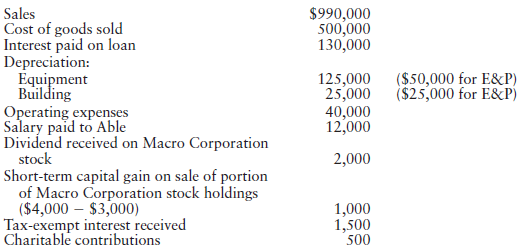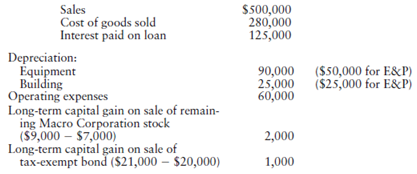Refer to the facts in Comprehensive Problem C:6-54. Now assume the entity is a partnership named Lifecycle
Question:
€¢ Except for precontribution gains and losses, the partners agree to share profits and losses in a 60% (Able)€”40% (Baker) ratio.
€¢ The partners actively and materially participate in the partnership€™s business. Thus, the partnership is not a passive activity.
€¢ Partnership debt is recourse debt.
€¢ The salary to Able is a guaranteed payment.
€¢ The refund for the NOL is not relevant to the partnership, nor are the E&P numbers.
€¢ In addition to the numbers provided for the assets on January 2, 2020, the following partnership book values apply:
Equipment €¦€¦€¦€¦€¦€¦......€¦€¦€¦$ 215,000
Building €¦€¦€¦€¦€¦€¦...........€¦€¦€¦€¦926,000
Land A €¦€¦€¦€¦€¦€¦€¦..............€¦€¦€¦.30,000
Land B €¦€¦€¦€¦€¦€¦€¦€¦..............€¦€¦.20,000
Total €¦€¦€¦€¦€¦€¦€¦.......€¦€¦€¦€¦.$1,191,000
€¢ On January 2, 2020, the partnership sells its assets and pays off the $1.87 million debt.
The partnership then makes liquidating distributions of the $490,000 remaining cash to Able and Baker in accordance with their book capital account balances.
Data from Problem C:6-54
The following facts pertain to Lifecycle Corporation:
€¢ Able owns a parcel of land (Land A) having a $30,000 FMV and $16,000 adjusted basis. Baker owns an adjacent parcel of land (Land B) having a $20,000 FMV and $22,000 adjusted basis. On January 2, 2017, Able and Baker contribute their parcels of land to newly formed Lifecycle Corporation in exchange for 60% of the corporation€™s stock for Able and 40% of the corporation€™s stock for Baker. The corporation elects a calendar tax year and the accrual method of accounting.
€¢ On January 2, 2017, the corporation borrows $2 million and uses the loan proceeds to build a factory ($1 million), purchase equipment ($500,000), produce inventory ($450,000), pay other operating expenses ($30,000), and retain working cash ($20,000). Assume the corporation sells all inventory produced and collects on all sales immediately so that, at the end of any year, the corporation has no accounts receivable or inventory balances.
€¢ Operating results for 2017 are as follows:
Sales €¦€¦€¦€¦€¦€¦€¦€¦€¦€¦€¦€¦€¦€¦€¦€¦€¦€¦ $964,000
Cost of goods sold €¦€¦€¦€¦€¦€¦€¦€¦€¦€¦ 450,000
Interest paid on loan €¦€¦€¦€¦€¦€¦€¦€¦.. 140,000
Depreciation:
Equipment €¦€¦€¦€¦€¦€¦€¦€¦€¦€¦€¦€¦€¦€¦ 70,000 ($25,000 for E&P)
Building €¦€¦€¦€¦€¦€¦€¦€¦€¦€¦€¦€¦€¦€¦€¦. 24,000 ($24,000 for E&P)
Operating expenses €¦€¦€¦€¦€¦€¦€¦€¦ 30,000
Of these amounts, $250,000 is qualified production activities income. The deduction percentage is 9%.
€¢ In 2018, Lifecycle Corporation invests $10,000 of excess cash in Macro Corporation stock (less than 20% owned) and $20,000 in tax-exempt bonds. In addition, the corporation pays Able a $12,000 salary and distributes an additional $42,000 to Able and $28,000 to Baker. The corporation also makes a $100,000 principal payment on the loan.
€¢ Results for 2018 are as follows:

Of these amounts, $158,000 is qualified production activities income. The deduction percentage is 9%.
€¢ In 2019, the corporation did not pay a salary to Able and made no distributions to the shareholders. The corporation, however, made a $30,000 principal payment on the loan.
€¢ Results for 2019 are as follows:

Of these amounts, qualified production activities income is zero (because it is negative).
€¢ On January 2, 2020, the corporation receives a refund for the 2019 NOL carried back to 2017. When carrying back the NOL, remember to recalculate the U.S. production activities deduction in the carryback year because of the reduced taxable income resulting from carryback. In addition, the corporation sells its assets, pays taxes on the gain, and pays off the $1.87 million remaining debt.

Required:
a. Determine the tax consequences of the partnership formation to Able, Baker, and Lifecycle Partnership.
b. For 2017 through 2019, prepare a schedule showing:
(1) Partnership ordinary income and other separately stated items
(2) Able€™s and Baker€™s book capital accounts at the end of 2017, 2018, and 2019
(3) Able€™s and Baker€™s bases in their partnership interests at the end of 2017, 2018, and 2019
c. For 2020, determine:
(1) The results of the asset sales
(2) Able€™s and Baker€™s book capital accounts after the asset sales but before the final liquidating distribution
(3) Able€™s and Baker€™s bases in their partnership interests after the asset sales but before the final liquidating distribution
(4) The results of the liquidating distributions, assuming a 23.8% tax rate (the 20% maximum capital gain rate plus the 3.8% rate on net investment income)
Accounts ReceivableAccounts receivables are debts owed to your company, usually from sales on credit. Accounts receivable is business asset, the sum of the money owed to you by customers who haven’t paid.The standard procedure in business-to-business sales is that... Partnership
A legal form of business operation between two or more individuals who share management and profits. A Written agreement between two or more individuals who join as partners to form and carry on a for-profit business. Among other things, it states...
Step by Step Answer:

Federal Taxation 2018 Comprehensive
ISBN: 9780134532387
31st Edition
Authors: Thomas R. Pope, Timothy J. Rupert, Kenneth E. Anderson





